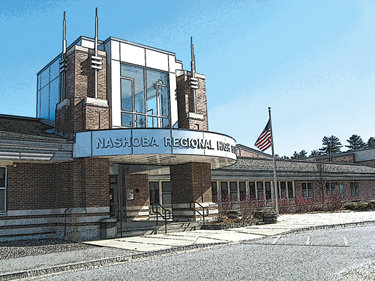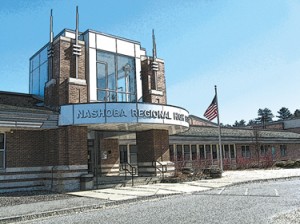
By Ann Needle 
As the Nashoba School Committee last Wednesday continued to work through goals for the year, it also took a closer look at some of the challenges of bringing technology into the classroom.
Nashoba Technology/Media Coordinator Cynthia Larsen presented an overview of the district’s proposed Digital Learning/Technology Plan, which stretches over 3 years. Larsen centered her remarks on the major goals for the upcoming year, including educator web sites, set up by November, that meet state requirements. Superintendent Michael Wood pointed out this will be part of the district’s revamping of its own site. Also, by May 2016 Nashoba aims to have curriculum units ready that demonstrate embedded use of student technology, and has already set up a “1:1 Chromebook initiative,” providing each eighth grader with a Chromebook for use both in and out of the classroom.
As for use of teaching technology, Larsen observed, “Current practices are very varied.” The SC agreed, with Lancaster Rep. Kathy Codianne pointing out that staff satisfaction with tech support (measured by last spring’s staff survey) ranged from less than 30% to more than 90%. She asked if the district could look again at tech staffing, especially as some of the designated tech support staff in each school also double as teachers.
Bolton Rep. Neal Darcy mentioned that, in the NEASC (New England Association of Schools and Colleges) re-accreditation report just issued on Nashoba Regional High School, several staff members commented that some tech issues take “days” to get fixed.
Larsen replied, “What’s challenging in this district is you have schools separated by miles,” and most issues must be addressed outside of teaching time. She also commented that the staff needs more professional development time devoted to technology, and recommended the district re-visit its Acceptable Use of Technology and BYOD (bring your own device) policies.
Cost-wise, Larsen explained that much of the online classroom work is conducted on Google Apps for Education—which is free to teachers—and Nashoba also has unlimited storage capacity on Google. The funding for this year’s Chromebook launch was built into the 2015/16 budget. But, she said she felt the district should still provide teacher leaders on technology with stipends.
Larsen said she aims to have the drafted Digital Learning Plan approved some time this fall.
Regarding the NEASC report, Michael Wood said there would be a formal presentation on the findings, likely in early October. Meanwhile, the report is on the school’s website.
Looking at the annual goals the SC approved for itself earlier this month, members focused on some new ideas for its goal of engaging the community. Suggestions included making sure there are SC representatives at each open house at schools throughout the district; turning the all-Nashoba staff roundtable of last January into an annual event; and conducting the recent, comprehensive staff survey every 2 years.
On a related topic, the SC also continued its ongoing discussion of making more aspects of Nashoba’s decision-making processes visible. The SC asked Wood if he could help provide meeting minutes or summaries from administrative and staff committees, such as STEM and Enrichment. Hesitating, Wood cautioned the SC it is venturing into new territory, however positive, and, “I want you to respect the fact that there’s a culture that exists, and you need to respect that.”
Salary Increase for Wood
The SC unanimously voted a 1% salary hike for Michael Wood, bringing his annual compensation to $169,127.
Wood announced that the district’s Comprehensive Reporting Committee will be working this year on putting in place a system for grading NRHS students against the state standards. Over the past few years, the Committee helped enhance the kindergarten through grade 8 report cards to include these standards. However, Wood stressed that the current letter grading system at the high school will likely stay intact, with some additions for measuring performance against state benchmarks.
Some budget impact could come from a recent state advisory informing districts that if a child—such as someone placed in a group home—is placed in a school district for 90 calendar days or more, then that district must take over the child’s schooling. Until now, Wood said that these students usually were transported to their home districts, “cost-sharing” the price with Nashoba.
Wood said that any impact to Nashoba—probably not immediate—would come from Lancaster’s Robert F. Kennedy School, plus another home in the district. He noted, “We have residences that have contracts for 15, but they could go up to 35 [students].”
In personnel news, Wood announced that Center School now has an assistant principal, Karen Cronin. She replaced Kelly Rogers, who resigned in August.
On a sadder note, Wood reported that staffer Donna Piper passed away suddenly Labor Day weekend. She had been with the district more than 20 years, including time at NRHS, and was currently with Luther Burbank Middle School in Lancaster as an instructional assistant.
As a Lancaster resident and former NRHS principal, Kathy Codianne said of Piper, “I get choked up — she really cared about the kids.”